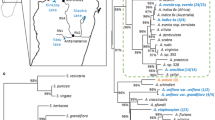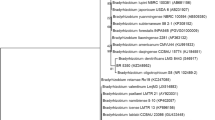Abstract
The occurrence and distribution of Azorhizobium and Rhizobium strains that induce stem nodulation of Sesbania rostrata were determined in four vegetation zones in Senegal. Based on tests with 16 Rhizobium and 10 Azorhizobium strains nodulating S. rostrata, a method was devised to distinguish among the strains. In all vegetation zones, members of both genera were more abundant in rhizosphere than nonrhizosphere soil under S. rostrata, Cassia obtusifolia, Acacia senegal, and Hystic suaveolens, and Rhizobium was present at higher densities than Azorhizobium. Azorhizobium was more abundant on the leaves and stems than Rhizobium in three of the vegetation zones, and the density of Azorhizobium but not Rhizobium was far greater on the leaves of S. rostrata than the three nonhost species in all four zones. Approximately 90% of the stem nodules and 39–48% of the root nodules on S. rostrata in all four zones were formed by Azorhizobium.
Similar content being viewed by others
References
Adebayo A, Watanabe I, Ladha JK (1989) Epiphytic occurrence of Azorhizobium caulinodans and other rhizobia on host and nonhost legumes. Appl Environ Microbiol 55:2407–2409
Alazard D (1985) Stem and root nodulation in Aeschynomene spp. Appl Environ Microbiol 50:732–734
Alazard D, Duhoux E (1987) Diversity of stem nodulation sites in Aeschynomene spp. J Plant Physiol 132:123–125
Becker M, Ladha JK, Ottow JCG (1990) Growth and N2-fixation of two stem-nodulating legumes and their effect as green manure on lowland rice. Soil Biol Biochem 22:1109–1119
Brockwell J (1980) Experiments with crop and pasture legumes—principles and practice. In: Bergersen FJ (ed) Methods for evaluating biological nitrogen fixation. Wiley, Chichester, UK, pp 417–488
Danso SKA, Alexander M (1974) Survival of two strains of Rhizobium in soil. Soil Sci Soc Am Proc 38:86–89
Dreyfus B, Dommergues Y (1980) Non-inhibition de la fixation d'azote atmosphérique par l'azote combiné chez une légumineuse à nodules caulinaires, Sesbania rostrata. C R Acad Sci Ser D 291:767–770
Dreyfus BL, Elmerich C, Dommergues YR (1983) Free-living Rhizobium strain able to grow on N2 as the sole nitrogen source. Appl Environ Microbiol 45:711–713
Dreyfus BL, Alazard D, Dommergues YR (1984) Stem-nodulating rhizobia. In: Klug MJ, Reddy CA (eds) Current perspectives in microbial ecology. Am Soc Microbiol, Washington, DC, pp 161–169
Dreyfus B, Garcia JL, Gillis M (1988) Characterization of Azorhizobium caulinodans gen. nov., sp. nov., a stem-nodulating nitrogen-fixing bacterium isolated from Sesbania rostrata. Int J Syst Bacteriol 38:89–98
Duhoux E (1984) Ontogénèse des nodules caulinaires du Sesbania rostrata (ĺegumineuses). Can J Bot 62:982–994
Fyson A, Sprent JI (1980) A light and scanning electron microscope study of stem nodules in Vicia faba L. J Exp Bot 31:1101–1106
Gibson AH (1963) Physical environment and symbiotic nitrogen fixation. I. The effect of root temperature on recently nodulated Trifolium subterraneaum L. plants. Aust J Biol Sci 16:28–42
Ladha JK, Watanabe I, Saono S (1988) Nitrogen fixation by leguminous green manures and practices for its inhancement in tropical lowland rice. (Sustainable agriculture: green manure in rice farming) International Rice Research Institute, Manila, pp 165–183
Ladha JK, Pareek RP, So R, Becker M (1990) Stem nodule symbiosis and its unusual properties. In: Gresshoff PM, Roth LE, Stacey G, Newton WE (eds) N2 fixation: achievements and objectives Chapman and Hall, New York, pp 633–640
Leben C (1965) Epiphytic microorganisms in relation to plant disease. Annu Rev Phytopathol 3:209–230
Leben C (1988) Relative humidity and the survival of epiphytic bacteria with buds and leaves of cucumber plants. Phytopathology 78:179–185
Legocki RP, Szalay AA (1984) Molecular biology of stem nodulation. In: Verma DPS, Hohn T (eds) Genes involved in microbe-plant interactions. Springer-Verlag, New York, pp 255–268
Lindow SE (1982) Population dynamics of epiphytic ice nucleation active bacteria on frost sensitive plants and frost control by means of antagonistic bacteria. In: Li PH, Sakai A (eds) Plant cold hardiness and freezing stress, vol. 2. (Mechanisms and crop implications). Academic Press, New York, pp 395–416
Lindow SE, Amy DC, Upper CD (1978) Distribution of ice nucleation-active bacteria on plants in nature. Appl Environ Microbiol 36:831–838
Liu C (1988) Integrated use of green manure in ricefields in South China. (Sustainable agriculture: green manure in rice farming.) International Rice Research Institute, Manila, pp 319–331
Martins O (1982) Geochemistry of the Niger River. In: Degens ET (ed) Transport of carbon and minerals in major world rivers. Part 1. Geologisch-Palaöntologischen Institut, University of Hamburg, Hamburg, Germany pp 397–418.
Ndoye I, Dreyfus B (1988) N2 fixation by Sesbania rostrata and Sesbania sesban estimated using 15N and total N difference methods. Soil Biol Biochem 20:209–213
Ndoye I, de Billy F, Vasse J, Dreyfus B, Truchet G (1994) Root nodulation of Sesbania rostrata. J Bacteriol 176:1060–1068
Nutman PS (1952) Studies on the physiology of nodule formation. III. Experiments on the excision of root-tips and nodules. Ann Bot 16:79–102
Pierce M, Bauer WD (1983) A rapid regulatory response governing nodulation in soybean. Plant Physiol 73:286–290
Rinaudo G, Dreyfus B, Dommergues Y (1983) Sesbania rostrata green manure and the nitrogen content of rice crop and soil. Soil Biol Biochem 15:111–113
Rinaudo G, Alazard D, Moudiongui A (1988) Stem nodulating legumes as green manure for rice in West Africa. (Sustainable agriculture: green manure in rice farming) International Rice Research Institute, Manila, Philippines, pp 98–109
Schaed R (1940) Die Knöllchen der adventiven Wasserwurzeln von Neptunia oleracea und ihre Bakteriensymbiose. Planta 31:1–21
Tsien HC, Dreyfus BL, Schmidt EL (1983) Initial stages in the morphogenesis of nitrogen-fixing stem nodules of Sesbania rostrata. J Bacteriol 156:888–897
Vincent JM (1970) A manual for the practical study of root-nodule bacteria. Blackwell Scientific Publications, Oxford
Author information
Authors and Affiliations
Rights and permissions
About this article
Cite this article
Robertson, B.K., Dreyfus, B. & Alexander, M. Ecology of stem-nodulating Rhizobium and Azorhizobium in four vegetation zones of Senegal. Microb Ecol 29, 71–81 (1995). https://doi.org/10.1007/BF00217424
Received:
Revised:
Issue Date:
DOI: https://doi.org/10.1007/BF00217424




